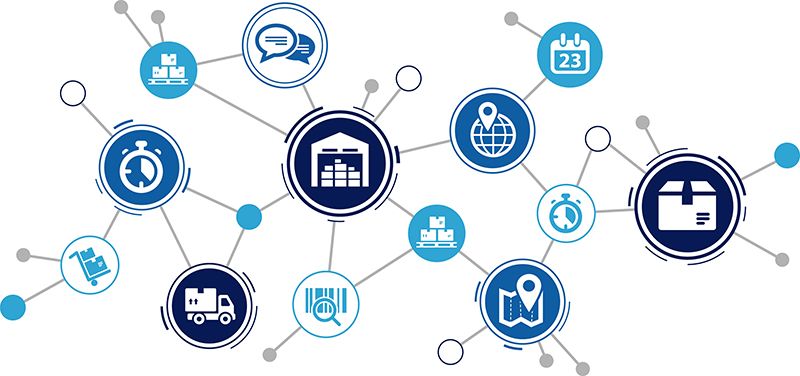What is Supply Chain Visibility?
Supply chain visibility is the ability to track the movement of raw materials, goods and products all the way from the supplier to the manufacturer to the end-consumer. When you increase supply chain visibility in your business, you’re taking an important step toward reducing errors, controlling costs and managing your inventory for overall improved customer satisfaction. Maintaining good supply chain visibility is an integral part of supply chain management.
The more complex a supply chain becomes, the more critical end-to-end visibility becomes. As more business functions become outsourced to companies around the world and customer expectations rise for speed and transparency in the products they buy, the modern supply chain has never been more complex.
But, with nearly all pain points, the opportunity is often hidden inside. The breadth and depth of a company’s visibility of its supply chain network have created an avenue for shippers and logistics service providers (LSP) to respond more nimbly to rapidly changing customer demands and conditions. In short, good supply chain visibility solutions allow managers to implement streamlined supply chain processes and quickly deal with supply chain disruptions before they cause major issues.
In this post, we’ll define supply chain visibility and discuss key elements to consider as you seek to increase supply chain visibility and get the most ROI out of your visibility efforts.
Table of contents
- Why is Supply Chain Visibility Important?
- 7 Benefits of Supply Chain Visibility
- How to Improve End-to-End Visibility Across the Order Lifecycle
- Common Challenges to Achieving Full Supply Chain Visibility
- Technologies That Enable End-to-End Visibility
- Measuring Success: KPIs for Supply Chain Visibility
- How enVista Can Help
Why is Supply Chain Visibility Important?
Supply chain visibility is important because it helps reduce errors and ensure a company can make and keep its promise to its customers. Visibility has everything to do with inventory management strategy, allocation and orchestration and means that you’re able to service the customer how, when and where they want.
As supply chain have grown more complex, businesses now need not only visibility across the traditional network of DCs and warehouses, but also into the inventory on hand with suppliers, 3PLs and in-store to orchestrate order fulfillment in a way that exceeds customer expectations while minimizing service cost.
Getting supply chain visibility right is critical to becoming an agile business that moves from being reactive to proactive and customer centric.

Increase ROI Through Successful Warehouse Slotting
A well-thought-out slotting strategy also enables businesses to minimize wasted space and maximize storage capacity within the warehouse. Increase ROI using the right tools, strategy and management plan with successful warehouse slotting.
7 Benefits of Supply Chain Visibility
The benefits of supply chain visibility show the many ways it can create a competitive advantage within an organization, including:
- Improved Forecast Accuracy – Real-time data enhances demand planning.
- Reduced Operational Risk – Early detection of bottlenecks mitigates supply chain disruptions.
- Faster Decision-Making – Access to centralized data enables agile responses.
- Cost Reductions – Improved routing, inventory management and labor efficiency lower expenses.
- Enhanced Customer Experience – Accurate delivery tracking improves satisfaction.
- Sustainability Gains – Better visibility helps optimize resources and reduce waste.
- Compliance and Audit Readiness – Easier to track regulations and reporting requirements reduce risk of detention, demurrage, delay and chargeback costs.
The benefits are often realized as soft cost savings. It can be difficult to create a compelling business case as a result, especially given the substantial resources required to implement full end-to-end visibility among all involved, including transportation management systems (TMS), order management systems (OMS), warehouse management systems (WMS) and enterprise resource planning (ERP) systems. So, the challenge with supply chain visibility is not whether to dedicate resources, but where and how much.
How to Improve End-to-End Visibility Across the Order Lifecycle
Simplistically, supply chain visibility can be broken down into three different stages and three levels of magnitude within each stage. In reality, the picture is not so clear, and there are times when a certain situation does not fit so cleanly into a specific stage or level of magnitude.
When deciding where to invest first for the greatest ROI, consider three stages of visibility as they occur during a shipment’s life cycle. First is the order stage when a specific quantity of a product is requested. Next is the in-transit stage which represents the physical movement of the items. Last is the invoice and audit stage, which is where the transaction among buyers, sellers and contracted LSPs is completed.
Within each of these stages, the level of visibility is determined by how an organization executes that task. In order of increasing the “field of view,” they can be completed three ways:
- Manually (through spreadsheets, emails and phone calls)
- Automatically (by system events entered by the user)
- Integrated Approach (messages and information exchanged by independent but connected systems and supply chain visibility software)
Stage 1: Visibility in the Order Stage
Before any product is created, it must be considered as an item entering the supply chain virtually, when it is “ordered” from buyer to seller. Typically dictated by a purchase order, the item has a real impact on inventory levels and therefore the bottom line on both the buyer and the seller.
Manual Execution
This is the lowest level of visibility and can create headaches for all parties involved, as it may require manually matching a purchase order to a sales order through spreadsheets containing hundreds of thousands of lines of data with no guarantee of accuracy.
Updates regarding freight ready date to customers and LSPs are typically pulled rather than pushed out. This puts all involved in a reactive state and creates a situation fraught with frustration, delays and unnecessary costs.
Automatic Execution
Automatic execution may be done through a sales order or purchasing system, either built in-house or purchased off the shelf. Rather than relying solely on emails and spreadsheets, these supply chain visibility software systems have a more deliberate approach to capturing and transmitting data.
Users can match a specific order with their purchase order/sales order and confirm the quantity, and LSPs and customers can receive freight-ready dates, giving decision makers the ability to make some adjustments if necessary. Schedule changes can be pushed from the system to relevant contacts when details are updated.
Automatic execution is still subject to human errors in data processing and entering, and a lack of integration with downstream or upstream systems limits visibility to just the order stage in the process.
Integrated Execution
An integrated approach, like the automatic approach, has an organized method for collecting and transmitting data. It captures order data, freight details and product-ready dates.
Going beyond automatic, integrated users from different departments have visibility to all relevant data, giving stakeholders the ability to make swift changes if required. Furthermore, integration allows relevant LSPs to get involved sooner, giving them the ability to plan the movement of the freight in advance.
An integrated environment greatly reduces the number of touch points and creates an organized workflow for individuals to perform the most important tasks first. An integrated approach may be accomplished by an OMS or TMS – or more likely a combination of both.
The integrated approach is the only method that sets an organization up for true end-to-end visibility, actively working downstream with both the in-transit and freight invoice audit stages that follow.
Stage 2: Visibility in the In-Transit Stage
After the product hits the warehouse floor, it’s ready to be moved. This can be carried out by truck, rail, air, ocean or a combination of modes. Transportation is one of the highest costs associated with a product. It’s also subject to market pricing swings that can drastically affect the cost.
Manual Execution
Visibility during this stage in a manual environment relies on operators exchanging phone calls and emails with carriers and relaying this information to the relevant parties. This is a time-consuming and reactive process.
Phone calls and emails are only good for providing information and aren’t actionable, offering little room for decision-makers to adjust accordingly. Manually executing visibility to in-transit shipments exposes shippers and LSPs to avoidable costs such as detention or demurrage, which must be passed along to the customer or written off by one of the parties.
Automated Execution
Visibility to the supply chain in an automated environment likely still relies on some emails and phone calls. However, using a TMS, those actions can be recorded to create usable data.
In an automatic environment, organizations have access to historical data, such as transit times, the volume of freight moving and transportation modes. These datasets can be used to make decisions such as how to staff warehouses appropriately, which lanes present the most challenges and whether it’s time to consider switching to a quicker mode.
While visibility into the past is much more robust than in a manual environment, this siloed TMS lacks agility in making quick decisions on shipments actually in transit. Shipments in transit are still subject to the same delays and costs associated with manual tracking. Updates can be pushed out from the system but still rely on a human at the other end to receive and process this information.
Integrated Execution
The integrated approach leverages the benefits of an automated environment and builds on them to enable organizations to adjust shipments in transit much easier with real time visibility.
At the center of an integrated approach is a fully implemented and integrated TMS. It exchanges information in real time with other systems within an organization and has electronic data interchange (EDI) with systems of other trading partners in the supply chain.
Using IoT systems and GPS monitoring, it’s possible to keep track of shipment locations, temperatures, weather patterns and more. This enables companies to proactively respond to changing conditions.
Application program interfaces (APIs) in a fully implemented network bridge the gap between different systems. They can complete tasks such as confirming if freight is ready for pickup, getting quotes from carriers and tendering shipments. Companies can find hard dollar savings in reduced transportation spend and soft cost savings in running an operation more efficiently.

Increase ROI Through Successful Warehouse Slotting
A well-thought-out slotting strategy also enables businesses to minimize wasted space and maximize storage capacity within the warehouse. Increase ROI using the right tools, strategy and management plan with successful warehouse slotting.
Stage 3: Visibility in the Payment and Invoice Audit Stage
Because the invoice audit and payment stage is further downstream, it doesn’t get the attention it deserves when it comes to supply chain visibility. While it may not have as direct of an impact on the ordering or movement of freight, it has a direct financial impact on a company’s supply chain. Full visibility in this stage directly translates to hard dollar savings.
Manual Execution
A manual environment in this stage entails working entirely off spreadsheets. This process is very time intensive, often requiring multiple full-time employees to manage.
Multiple audits help reduce the amount of error, but they come at the cost of crippling an organization’s cash flow. A single shipment may have several invoices associated with it, all being sent at different times. Without upstream visibility, pairing invoices quickly becomes an extremely fractured task that ties up too many internal resources.
Automatic Execution
Automating the freight invoice and auditing phase is typically done through an on-premises or cloud-based program like QuickBooks. Although that software runs more efficiently than keeping data on spreadsheets, since it’s specifically designed for accounting functions, the process of keeping track of invoices and auditing is still time-consuming, and data silos may still exist.
An automated solution doesn’t give upstream visibility to finances related to the order or in-transit stages, so organizations still require a balancing act between the time spent auditing invoices and keeping a stable cash flow.
Integrated Execution
Fully integrating this stage opens a full line of sight into the financial portion of the supply chain as soon as a customer places an order. A fully integrated software suite communicates with OMS, WMS, and TMS systems to provide true upstream visibility of the associated costs and spend across the entire supply chain.
Electronic documents and EDI systems help ensure timely, accurate invoicing and facilitate better cash flow management. Standardizing the formats used and enabling data sharing between platforms offers ROI in several areas of the operation.
Rather than pulling this information from separate and disparate systems manually or through a QuickBooks application, a truly integrated platform centralizes the information, reducing the time and effort spent on manually creating reports needed to drive intelligent business decisions.
Common Challenges to Achieving Full Supply Chain Visibility
Achieving end-to-end supply chain visibility requires both technical investment and stakeholder buy-in. Fragmented data systems, limited infrastructure and inconsistent standards across technology partners can make integration challenging. Companies relying on legacy software without a centralized platform for their supply chain management will struggle with the technical aspects of project implementation.
It’s also important to consider the human factors that can make supply chain visibility a challenge. Proper change management is essential to ensure stakeholder buy-in. Without support from all departments, any investment is not likely to succeed.
Technologies That Enable End-to-End Visibility
Several technologies are involved in end-to-end supply chain visibility implementations. WMS platforms assist with monitoring stock levels and the early part of the order process. ERP and transportation management systems offer real-time shipment tracking and can be supported by AI/ML systems to improve visibility into each stage of the shipping process.
AI/ML can also assist with demand forecasting and even manage route planning and orders. Blockchain technologies can be used to create immutable ledgers and records.
Measuring Success: KPIs for Supply Chain Visibility
To judge the ROI of your supply chain visibility projects, consider tracking the following metrics:
- On-Time In-Full (OTIF)
- Inventory turnover
- Fill rate
- Order cycle times
- Order accuracy
- Stockouts
Tracking these metrics helps assess the effectiveness of your visibility initiatives and can highlight areas where optimization is required.
How enVista Can Help
enVista’s supply chain experts have deep expertise in complex systems integrations of supply chain technologies (WMS/TMS/OMS/ERP). These systems solve critical operational challenges and provide real time visibility of supply chain data. enVista is uniquely equipped to provide end-to-end services across assessment, selection, implementation, go-live support and change management for your critical transportation projects.
Clients leverage enVista as a single, trusted partner to help them drive positive customer experiences, cost savings, revenue and profitability across the arc of modern-day commerce. Our supply chain management experts can help you determine where to invest first regarding supply chain visibility to generate ROI at the quickest time to value.





